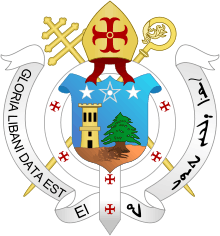Mardaites
| Part of a series on |
| Maronites |
|---|
 |
| Maronite Church |
| Communities |
| Languages |
|
|
| History |
| Politics |
|
|
The Mardaites (Greek: Μαρδαΐται) or al-Jarajima (Syriac: ܡܪ̈ܕܝܐ; Arabic: الجراجمة / ALA-LC: al-Jarājimah), inhabited the highland regions of the Nur Mountains. The Mardaites were early Christians following either Miaphysitism or Monothelitism and bear a possible, but unconfirmed, relation to the Maronites.[1] Little is known about their ethnicity, it has been speculated that they might have been Persians or Armenians, yet other sources claim them to have been native to the Levant or possibly even from the Arabian peninsula.[1] Their other Arabic name, al-Jarājimah, suggests that some were natives of the town Jurjum in Cilicia (Tachkastan). They were joined later by various escaped slaves and peasants during their insurgency and were said to have claimed territory from "the Holy City" to the "Black Mountain".[2]
History
According to some historians, after the Muslim conquest of the Levant, the Mardaites gained a semi-independent status around the Nur Mountains within al-ʿAwāṣim, the Byzantine-Arab border region. They initially agreed to serve as mercenaries for the Arabs and to guard the Amanian Gate, but their loyalty was intermittent and they often sided with the Byzantine Empire as their agenda varied.[2]
According to Greek and Syriac historians, their territory stretched from the Amanus to the "holy city", the latter often identified as Jerusalem, although more likely to refer to Cyrrhus, also called Hagioupolis, the capital of Cyrrhestica, in upper Syria.[3]
Their numbers were swelled by thousands of runaway slaves, making them an ethnically diverse group. In light of this, it is claimed that they forced Muawiyah I, Caliph of the Umayyad Caliphate, to pay tribute to the Byzantine emperor Constantine IV, or possibly to them instead.[3] Emperor Justinian II sent the Mardaites again to raid Syria in 688/9; this time they were joined by native peasants and slaves and were able to advance as far as Lebanon. The Umayyads were compelled to sign another treaty by which they paid the Byzantines half the tribute of Cyprus, Armenia and the Kingdom of Iberia in the Caucasus Mountains; in return, Justinian relocated around 12,000 Mardaites to the southern coast of Anatolia, as well as parts of Greece such as Epirus and the Peloponnese, as part of his measures to restore population and manpower to areas depleted by earlier conflicts.[2][4] There they were conscripted as rowers and marines in the Byzantine navy for several centuries.[5] Others however remained behind and continued raiding Muslim-held territories until their chief stronghold fell to Umayyad prince-general Maslama ibn Abd al-Malik in 708. Maslama(h) then resettled them throughout Syria, and although he allowed them to retain their faith, he conscripted them into his army.[1]
The Maronites
Many Maronites claim that the modern Maronites are of Mardaite ancestry, and oral tradition is said to indicate this. However, documented evidence is sporadic at best as the Maronites sources are recent due to their lack of a thorough recorded history beyond the 16th century, leaving the matter open for debate among historians. That being said, Maronite oral tradition does mirror much of the history of the Mardaites. However, it is possible that the similarities are superficial and the groups are similar, but unrelated. In reality there is no way to prove or disprove this connection. However, the Maronites do lack a thorough recorded history and oral traditions are unlikely to have been falsified in isolated mountain communities. Many attribute the view that the Maronites are unrelated to the Mardaites due to early historic bias, when the West favored the Druze until the pogroms of Syria in the 19th century which resulted in the death of 300,000 Maronites and other Christians at the hands of the Druze as a reprisal for Maronite attempts to retake lost territory in the South of Mount Lebanon.
This term was adopted by the Marada Movement during the Lebanese Civil War because of their Phoenicianist views of the origin of the Lebanese people.
See also
Notes
- 1 2 3 Kazhdan, Alexander (Ed.) (1991), Oxford Dictionary of Byzantium, Oxford University Press, p. 1297, ISBN 978-0-19-504652-6
- 1 2 3 Canard, M. "Djaradjima". In P. Bearman; Th. Bianquis; C.E. Bosworth; E. van Donzel; W.P. Heinrichs. Encyclpoaedia of Islam. 2 (2 ed.). BRILL. p. 457.
- 1 2 Woods, David. "Corruption and Mistranslation: The Common Syriac Source on the Origin of the Mardaites". Retrieved April 6, 2013.
- ↑ Ostrogorsky, George; Hussey (trans.), Joan (1957), History of the Byzantine state, New Brunswick, N.J.: Rutgers University Press, pp. 116–18, ISBN 0-8135-0599-2
- ↑ Treadgold, Warren T. (1998), Byzantium and Its Army, 284–1081, Stanford University Press, p. 72, ISBN 0-8047-3163-2
References
- Makrypoulias, Christos G. (2005), "Mardaites in Asia Minor", Encyclopedia of the Hellenic World - Asia Minor
- Phares, Walid. Lebanese Christian Nationalism: The Rise and Fall of an Ethnic Resistance. Boulder and London: Lynne Rienner Publishers, 1995.
- Salibi, Kamal. A House of Many Mansions: The History of Lebanon Reconsidered, London: I B Tauris, 1988.
- Salibi, Kamal. Maronite Historians of Medieval Lebanon, Beirut: American University of Beirut, 1959.
- Salibi, Kamal. The Modern History of Lebanon, Delmar: Caravan Books, 1977.